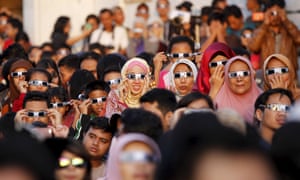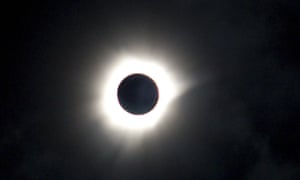Solar Eclipse 2016
Total Solar Eclipse Wows Skywatchers
The skies went dark over parts of Indonesia and the Pacific Ocean
region Tuesday evening (March 8) as the only total solar eclipse of 2016
took hold.
The moon briefly blotted out the sun for observers in a 90-mile-wide (145 kilometers) strip of land and sea — the “path of totality” — that stretched east across Sumatra, Borneo, Sulawesi and other islands, all the way to an empty patch of the Pacific northeast of Hawaii.
“We’ve got totality here!” Paul Cox said Tuesday evening from Sulawesi, where he had traveled to host a live eclipse webcast for the Slooh Community Observatory. [Video: NASA Explains the Total Solar Eclipse of 2016]
“I can now see prominences — they are beautiful. Wow!” Cox added. His excitement then ratcheted up even more as he witnessed the “diamond ring effect,” in which the sun-moon pair resembles a piece of gigantic sky bling. “That is the most beautiful thing I’ve ever seen.”
Indeed, the next solar eclipse — which will be visible from parts of Africa on Sept. 1 — will be the annular type.
North American skywatchers may feel left out by Tuesday’s event and the upcoming African eclipse, but their time is coming. On Aug. 21, 2017, a total solar eclipse will be visible from a swath of the north-central United States stretching from Oregon to South Carolina. And most of North America will be able to catch a partial version of this “Great American Eclipse.”
The moon briefly blotted out the sun for observers in a 90-mile-wide (145 kilometers) strip of land and sea — the “path of totality” — that stretched east across Sumatra, Borneo, Sulawesi and other islands, all the way to an empty patch of the Pacific northeast of Hawaii.
“We’ve got totality here!” Paul Cox said Tuesday evening from Sulawesi, where he had traveled to host a live eclipse webcast for the Slooh Community Observatory. [Video: NASA Explains the Total Solar Eclipse of 2016]
“I can now see prominences — they are beautiful. Wow!” Cox added. His excitement then ratcheted up even more as he witnessed the “diamond ring effect,” in which the sun-moon pair resembles a piece of gigantic sky bling. “That is the most beautiful thing I’ve ever seen.”
Indeed, the next solar eclipse — which will be visible from parts of Africa on Sept. 1 — will be the annular type.
North American skywatchers may feel left out by Tuesday’s event and the upcoming African eclipse, but their time is coming. On Aug. 21, 2017, a total solar eclipse will be visible from a swath of the north-central United States stretching from Oregon to South Carolina. And most of North America will be able to catch a partial version of this “Great American Eclipse.”
Total solar eclipse: Thousands across Indonesia witness rare celestial event
As a solar eclipse arched across the skies of Indonesia on Wednesday, tens of thousands of people across Indonesia gazed upward, hoping for a glimpse of the rare natural phenomenon.
Crowds started to form at the observatory in central Jakarta as early as 3am with eclipse watchers arriving early to receive a free pair of glasses and secure the best spot.
Some brought picnics with them, while others climbed onto the observatory roof or perched on top of idle fire trucks to escape the hordes
As the moon started to pass between the earth and the sun, the skies took on an unusual twilight tone, and the first crescent became visible.
“I felt the greatness of creation when I saw it,” exclaimed Wiwi, a Jakarta resident.
“It’s so coooool,” said Fabio, aged 5, “The sun looks like the moon!”
A solar eclipse results when the moon passes directly between the Earth and the sun, casting a shadow over the Earth. It is only possible during the new moon phase, when the dark side of the moon faces the Earth.
Only a partial eclipse, about 88% coverage of the sun, was visible from
Jakarta but it did not disappoint viewers.
“I was so excited the first time I saw it!” said Yahra, a high-school student, viewing
the eclipse through a piece of potato crisp packet.

One man grabbed an x-ray of his broken leg, and invited a handful of people to huddle behind it and watch the eclipse with him.
“I came for the free glasses but there weren’t any left,” said Abdul Rahman, 36,
“Anyway, the x-ray material was very clear, better than the glasses.”
As the eclipse coincided with a national holiday for Nyepi, or Balinese New Year,
many used the holiday to enjoy the day out with their families.
Ongko Wiyono, 45, a civil servant woke up hours before dawn to get to the observatory with his wife and two children.
“It’s so different to the last eclipse,” he said, “This time the government is giving the public the opportunity to see it and really encouraging us to learn about it. I bought my kids here so they could really experience it.”
When there was a solar eclipse in Indonesia in 1983 the government warned people to stay indoors fearing the natural phenomena would have negative health impacts, or cause blindness. Some pregnant women even hid under the covers.
But this year the authorities had been actively promoting the eclipse
and there was a string of colorful events across the country.
Without the cloud cover a total eclipse would have been visible from 12 of 34 provinces in Indonesia.
But while Jakartans were enthralled by the planetary alignment, some viewers in other parts of the country were thwarted by the overcast weather.
Despite the intermittent rain, cultural researcher Karen Macdonald and her husband John scrambled up a muddy slope 40km from Palangkaraya in Central Kalimantan hoping to witness the event.
“The sky darkened quickly and dramatically and then it was like the dimmers had
been turned back on very fast,” said Macdonald, “It was all over in two and a half minutes.”
A 50% eclipse was also visible in northern Australia.
Those near the top end of the Northern Territory had the best view in the country, with about half the sun covered after 10am.
In Darwin dozens of people crowded the CBD mall to hear from Geoff Carr, who described himself as “not quite an umbraphile but pretty close to it”, and look through his variety of eclipse-viewing tools.
Staring at the sun does obvious damage to the eyes and so viewers were armed with an array of devices of varying degrees of technical advancement. Some made pinhole projectors from two pieces of paper, others had fashioned welding glass into a viewer. Passersby lined up to look at the sun through Carr’s large telescope and German solar filter.
“Every eclipse is unique,” Carr, an astronomy enthusiast and star tour operator, told the Guardian.
“Sometimes there are just partial eclipses. Sometimes there are full eclipses and sometimes there are what’s called annular eclipses. That is when the moon doesn’t appear quite big enough to block the sun out completely so you get that ring of sun effect.”
According to Nasa the next solar eclipse will occur in 2017 and will be visible from the United States.
Partial solar eclipse in India today
Partial solar eclipse in India today
Solar Eclipse 2016
![Solar Eclipse 2016]() Reviewed by Unknown
on
21:32:00
Rating:
Reviewed by Unknown
on
21:32:00
Rating:


No comments: